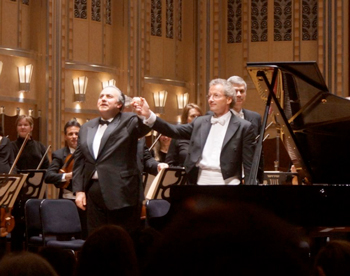by Daniel Hathaway

Music director Franz Welser-Möst flanked Bartók’s Second Piano Concerto with two very different Prokofiev symphonies. The “Classical” (which the composer didn’t like to label as No. 1) is cheerful, congenial, and well-behaved, with just enough Prokofievan mischief tucked in to trace its paternity. The Third Symphony, rarely played, repurposes material from the seldom if ever performed opera The Fiery Angel.
While the “Classical” is a piece that wants to be liked, the Third doesn’t care, presenting the listener with 35 minutes of musical malevolence made attractive chiefly through a continuous flow of new ideas and the composer’s compelling orchestration — importantly featuring the contrabassoon.
Prokofiev said that in the process of reshaping material from the opera, he disassociated the music from the plot of the stage work (Satanic possession in a nunnery). But much of the hysteria experienced by its principal character comes across into the symphony. It’s gripping stuff, and it’s thrilling to be caught up in it.
The Orchestra played the “Classical” with elegance and precision and went full throttle in the Third, wringing every bit of drama and color out of an unusually evocative score. Before the latter, Welser-Möst spoke to the audience about Prokofiev’s music and the complexity of the human soul. He should do this more often, because he has interesting and usually very philosophical remarks to share, but a microphone would make him more audible in the hall.
The real torso of Thursday evening’s concert was the Bartók, which the composer himself played with the Orchestra and Artur Rodzinski in Severance Hall in December of 1940. That would have been something to hear. The piece is relentlessly virtuosic, with complex, hammering rhythms and parallel chords — reminiscent of Stravinsky’s Petrushka — that might send the unfit into weeks of physical therapy. But not Yefim Bronfman, who can play white-hot music with cold-blooded ease.
The strings sit out the whole of the first movement, which makes their edge-of-silence, non-vibrato chords at the beginning of the second all the more striking. But Bartók doesn’t let things relax for too long. After a terse conversation between piano and timpani, he plunges into another busy, percussive episode before returning to the stasis of the beginning. And for the third movement? Yet another dizzifying sprint for the soloist and the orchestra that makes a brief side trip into a cadenza for piano and bass drum before shooting forward to a brilliant finale. The by now breathless audience gave Bronfman, Welser-Möst, and the Orchestra a deservedly handsome ovation.
Photo by Roger Mastroianni from an earlier performance.
Published on ClevelandClassical.com October 2, 2018.
Click here for a printable copy of this article



